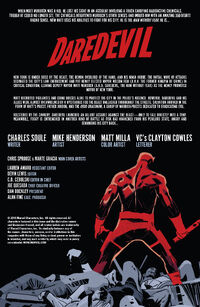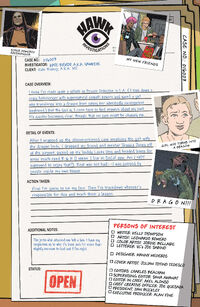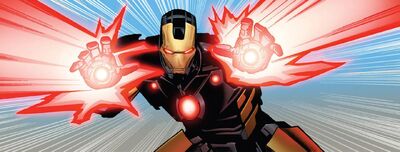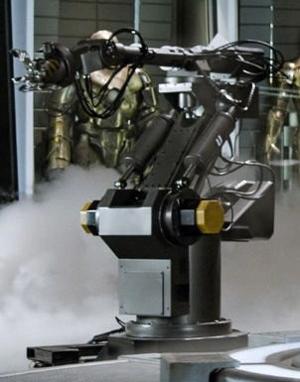Radar Sense

Radar sense is an extranormal means of perception by which the brain generates electromagnetic waves which travel outward, bounce off objects, and are again picked up by the brain, which thus determines what its surroundings are.

Notable Characters with Radar Sense
For a full list of characters with radar sense, see here
- Daredevil (Earth-616)
- Namor
- Mentallo
- Stick
- Rocket Raccoon
- Banshee
- Gorgon
- Regent
- Daredevil (Earth-199999)
- Mole Man
- Shroud
- Ikari
- Venom
[top] [Edit Radar Sense]
Realm
[top] [Edit Realm]
Reality
A reality is the collection of a universe where a version of the planet Earth exists and shares space and time with the corresponding celestial bodies (an Earthspace), and the various other dimensions associated with it, like Asgard, the Dark Dimension or the Negative Zone, to name a few. Universes where a planet Earth exists are infinite, and there is (generally) one version of Asgard, one version of the Dark Dimension, one version of the Negative Zone, and so on, associated with each.[1]
Most stories take place on Earth, so this planet is arbitrarily regarded as the nucleus of the reality it belongs to. Because of this, the term "Earth" is often used interchangeably with "reality," specifically in regards to the concept of alternate realities. In a similar context, the term "universe" is also used to refer to a reality, since the Earth is contained within a universe-type of dimension.
Realities are categorized using a numbering system, with each reality being assigned a unique number. The most correct term to designate a reality is "Reality-XXXX" (with the unique numeration of a given reality replacing "XXXX"). However, due to the aforementioned placement of the Earth as the centerpiece of any given reality, reality designations commonly use the prefix "Earth-" instead, thus "Reality-616" is colloquially known as Earth-616.[1]
(See Also: Multiverse/Universe Listing, Dimension, Universe, Alternate Reality)
- ↑ 1.0 1.1 Omniverse: A Glossary of Terms The Appendix to the Handbook of the Marvel Universe. Retrieved on 19 November 2019.
[top] [Edit Reality]
Reality Warping

Reality warping is the ability to alter reality, and is often regarded as the ultimate superpower. Generally, it translates as the ability to reshape matter and energy, turn a person's thoughts or desires into reality, bend time and space to travel across timelines and between dimensions, bend, twist or even rewrite the laws of physics, and erase virtually anything.[1]
Some of the most extreme reality warpers, like Mad Jim Jaspers, are not even limited by their own physical bodies and can alter their own stature and appearance at will, no matter how bizarre it might be. This ability seems to go far beyond anything that "ordinary" shapeshifters like Mystique and Morph could even think of in their wildest imagination.
According to Dr. Doom, those who warp reality have a spark of magic within them.[2] According to Wiccan, reality warping is greater than magic.[3]
Reality warping can be achieved by different methods. For example, Jamie Braddock manipulates strings while Proteus' reality warping is psionic in nature.[4]
- Notable Reality Warpers
For a list of all known reality warpers, see here.
- Alfie O'Meagan
- Franklin Richards
- Jamie Braddock Jr.
- Legion
- Mad Jim Jaspers
- Marquis of Death
- Matthew Malloy
- Phoenix
- Proteus
- Scarlet Witch
- Wiccan
- X-Man (normally small in scale; increased to considerable levels with the Life Seed)
Also, most high-level cosmic beings are nigh-omnipotent and have reality-altering powers.
- Notable items that can reality warp
Trivia
(See Also: List of reality warpers)
Reboot
Reboot means to discard all previous continuity in the series and start anew. Effectively, all previously-known history is declared by the writer to be null and void and the series starts over from the beginning. This differs from a creator producing a separate adaptation of another creator's work in an alternate reality and instead requires that the rebooted continuity supersede the older continuity as the new official version.
This term is often applied to comic books, where the prevailing continuity can be very important to the progress of future installments, acting (depending on circumstances and one's point of view) as a rich foundation from which to develop characters and storylines, or as a box limiting the story options available to tell and an irreconcilable mess of contradictory history. Such large continuities also become a barrier to introducing newcomers to the fandom, as the complex histories are difficult to learn, and make understanding the story very difficult; a reboot would theoretically give the chance for new fans to experience the story by reintroducing it in smaller and easier to understand installments; however, this has never "officially" happened in Marvel Comics, although there are several instances where it was attempted, and the new continuity was instead later relegated to alternate realities.
Examples
- In the mid-1990s, Marvel turned several of their titles over to studios affiliated with Image Comics, and these titles (Fantastic Four, Captain America, the Avengers, and Iron Man — the Hulk would be included in this trend only as a character, but without his own title) were adapted in a new continuity; meanwhile, the rest of Marvel's line maintained the original continuity in which the affected characters were presumed to have died in a cataclysmic battle. The new titles lasted only a year, at which point the heroes involved returned to the original universe and the perceived rebooted continuity was integrated into the original continuity. (See Heroes Reborn.)
- In addition, Marvel Comics also published Spider-Man: Chapter One by John Byrne, which was meant to be a complete reboot to the Spider-Man series and was treated as such until editorial changes relegated the series to alternate universe status, making all potential changes the original continuity null and void.
- In 2000, Marvel launched the Ultimate Marvel line of comic books that adapted the Marvel Universe. The Ultimate series was intended to modernize the characters, to rewrite the individual characters into a more cohesive universe, and to make the series more appealing to non-Marvel fans; the huge back-story of the Marvel Universe, made it very difficult for newcomers to understand the characters and storylines. Unlike most reboots; however, the original Marvel Universe continued to publish as well. This ensured the two continuities existed as parallel universes rather than a true reboot.
- Between 2003-2005, Marvel ran Supreme Power, a modernization of Squadron Supreme, which like the Ultimate Marvel line, ran concurrently with the original continuity in another alternate Universe instead of replacing the existing line.
(See Also: Canon, Retcon)
[top] [Edit Reboot]
Recap Page

A standard recap page
A recap page is an expository device that constitutes of a single page (and sometimes a splash page) at the beginning of a comic that features a summary of important events that have ocurred in previous issues and even basic information about the series' protagonist(s), so that readers can quickly catch up on a series' ongoing narrative, making them especially useful for new readers. The use of recap pages additionally helps writers avoid having to integrate this kind of exposition into the story of a comic. Comic series starring a group of characters like Avengers or X-Men will usually include mugshots of the book's protagonists as well.
A precedent of recap pages was a brief block of text which presented the basic information of a series' protagonist in the same page where the title of a comic's story was displayed. Both of these elements are usually integrated into the recap pages nowadays, together with other information, like author credits, and the issue's indicia.

A less conventional recap page
[top] [Edit Recap Page]
Reincarnation
(See Also: Characters with Reincarnation)
[top] [Edit Reincarnation]
Reflexes
[top] [Edit Reflexes]
Repulsor

A repulsor is a form in which a high density muon beam[1] can be projected, as a powerful blast of concussive energy called repulsor blasts. Repulsor blasts may be directed by magnets and focused by electrostatic lenses, although they may also be self-focusing. One of the luminaries of repulsor design technology is Tony Stark, who has incorporated them into every iteration of his patented Iron Man armors since Model 3. Constructed using micro-circuitry, these repulsors are implemented into the palms of his battlesuit and are one of the armor's primary offensive tools.
The main usage of repulsors is for defense, as the blast in which they're emmited can even vaporize enemies. They can also be used to stabilize flight in the case of being used in Iron Man armors.
A repulsor generator is an electronic device which uses particle beam technology to project a repulsor blast. In numerous attacks perpetuated by Ezekiel Stane, all the repulsor generator units from Stark Industries, the only creator of this technology in the world, were destroyed. Luckly, Tony Stark had created a new miniaturized repulsor generator, called Repulsor Tech node, which he would later use to power himself, his armors and produce them in mass to finance his new creations for his new enterprise, Stark Resilient.
The latest model of Repulsor technology named is that of Mark IVa, featuring a different color for its beams, red.[2]
(See Also: Anthony Stark; Iron Man Armor)
[top] [Edit Repulsor]
Retcon
A retcon (short for retroactive continuity) is, in a nutshell, a storyteller's tool that adds previously unknown material to an event in a previous story. As with any tool, the quality of the finished product depends on the user's skill and intent.
A retcon can be a good thing. If your favorite villain seemed to die in his last outing, you might prefer to believe that he didn't really die, so that he can make another appearance. A writer can (and usually does) oblige you by "resurrecting" that villain. Suppose that Doctor Doom, when you last saw him, was clinging to an asteroid on its way to the edge of the solar system. You would have to assume that he died, although you wouldn't know it for certain.
Now suppose that, months later, another writer wants to bring Doctor Doom into another story. It would strain your credulity to see him alive with no explanation. Continuity, an element of good storytelling, demands that the writer explain how Doom returned from his trip into space. The writer tells you something you didn't know at the time—"of course Doom has a jetpack built into his armor"—problem solved. With few exceptions, a writer will leave some ambiguity in these situations, precisely so that later writers can use the character again.
A retcon can also solve problems created by other writers. In a serial medium such as comic books, the creative teams change from time to time, and each team has its own conceptions of the characters. If the previous team made a change that doesn't fit in with the new team's ideas, they can explain it away. In an extreme example of such a retcon, an entire season of the television series Dallas was undone by retroactively presenting it as a bad dream of one of the characters.
On the other hand, a retcon can be a bad thing. The only rule in writing is that there are no rules, but there are guidelines.
Guideline #1: play by the rules. All fiction depends on suspension of disbelief, your willingness to accept a story on its face. It may violate the rules of our world, but you ignore the impracticality as long as the story is internally consistent. In this type of bad retcon, someone does something out of character, or something happens that directly contradicts what previous writers have accepted as true. In other words, the retcon involves something inconsistent with the accepted "laws" of that fictional world.
Guideline #2: use them sparingly. A retcon pulls you out of the story for a moment, forcing you to evaluate it in light of what you already know. If it's plausible and consistent, you'll accept it quickly and go on with the story. Further retcons keep pulling you back out of the story and ruin the experience.
Guideline #3: keep it simple. A retcon adds new material to an old story. If you have read the old story, or first read it at a later time, you will feel cheated because so much was "left out."
Guideline #4: show respect. Some comic-book events have become legends. Changing them retroactively cheapens them.
[top] [Edit Retcon]
Robot

A robot is a mechanical or virtual artificial agent, usually an electro-mechanical machine that is guided by a computer program or electronic circuitry. Robots can be autonomous or semi-autonomous and range from humanoids, to industrial robots, collectively programmed swarm robots, and even microscopic nano robots. By mimicking a lifelike appearance or automating movements, a robot may convey a sense of intelligence or thought of its own.
This could include Androids, Synthezoids, embodied artificial intelligence, and Golems.
(See Also: * List of Robots, Appearances of Robots)
[top] [Edit Robot]
